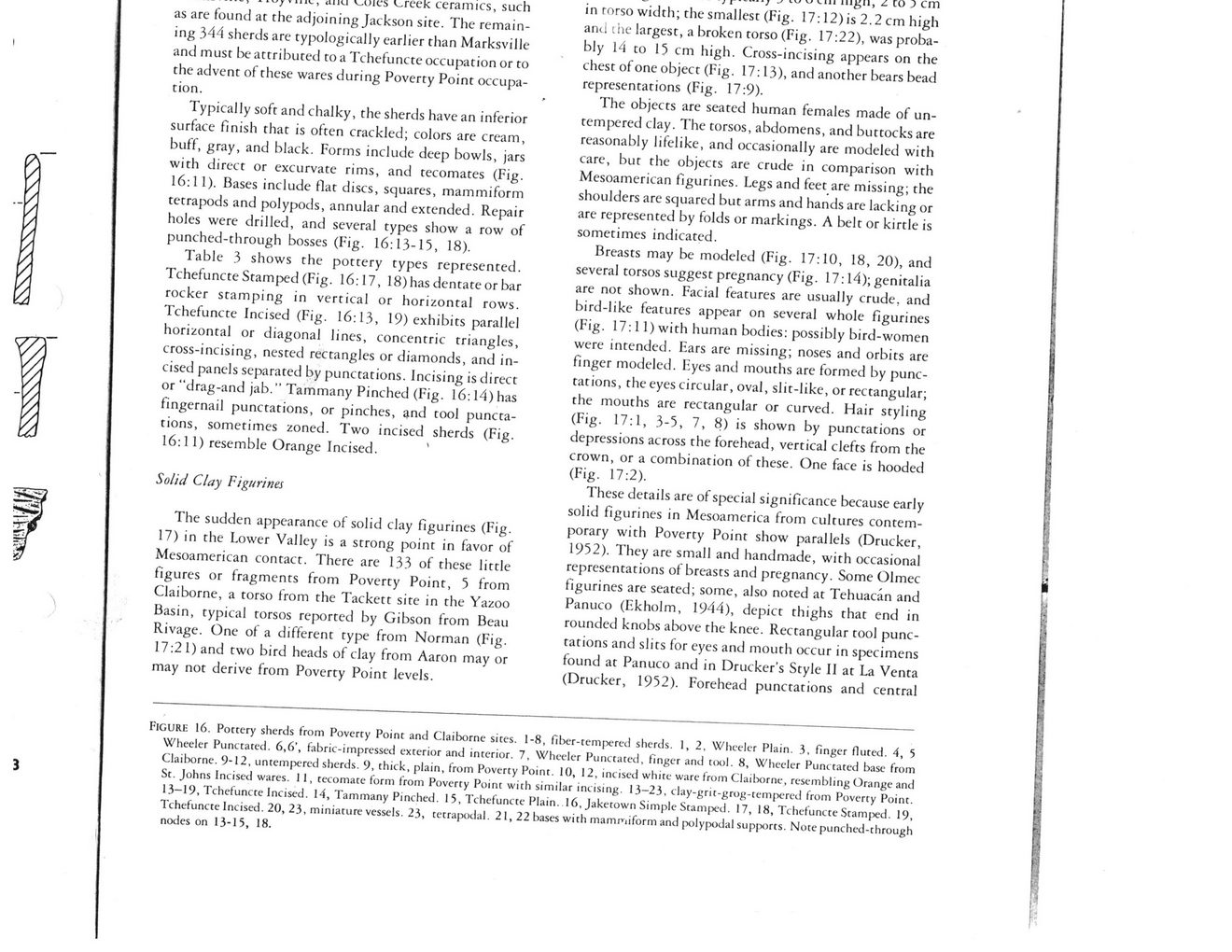This text was obtained via automated optical character recognition.
It has not been edited and may therefore contain several errors.
-____, auu v-oies creek ceramics, such as are found at the adjoining Jackson site. The remaining 344 sherds are typologically earlier than Marksville and must he attributed to a Tchefuncte occupation or to the advent of these wares during Poverty Point occupation. Typically soft and chalky, the sherds have an inferior surface finish that is often crackled; colors are cream, buff, gray, and black. Forms include deep bowls, jars with direct or excurvate rims, and tecomates (Fig. 16:11). Bases include flat discs, squares, mammiform tetrapods and polypods, annular and extended. Repair holes were drilled, and several types show a row of punched-through bosses (Fig. 16:13-15, 18). Table 3 shows the pottery types represented. Tchefuncte Stamped (Fig. 16:17, 18) has dentate or bar rocker stamping in vertical or horizontal rows. Tchefuncte Incised (Fig. 16:13, 19) exhibits parallel horizontal or diagonal lines, concentric triangles, cross-incising, nested rectangles or diamonds, and incised panels separated by punctations. Incising is direct or “drag-and jab. ” Tammany Pinched (Fig. 16:14) has fingernail punctations, or pinches, and tool punctations, sometimes zoned. Two incised sherds (Fig. 16:11) resemble Orange Incised. ' Solid Clay Figurines The sudden appearance of solid clay figurines (Fig. 17) in the Lower Valley is a strong point in favor of Mesoamerican contact. There are 133 of these little figures or fragments from Poverty Point, 5 from Claiborne, a torso from the Tackett site in the Yazoo Basin, typical torsos reported by Gibson from Beau Rivage. One of a different type from Norman (Fig. 17:2 1) and two bird heads of clay from Aaron may or may not derive from Poverty Point levels. j f— .j _/ u (.in tu^n, z co ) cm in rorso width; the smallest (Fig. 17:12) is 2.2 cm high and the largest, a broken torso (Fig. 17:22), was probably 14 to 15 cm high. Cross-incising appears on the chest of one object (Fig. 17:13), and another bears bead representations (Fig. 17:9). The objects are seated human females made of untempered clay. The torsos, abdomens, and buttocks are reasonably lifelike, and occasionally are modeled with care, but the objects are crude in comparison with Mesoamerican figurines. Legs and feet are missing; the shoulders are squared but arms and hands are lacking or are represented by folds or markings. A belt or kirtle is sometimes indicated. Breasts may be modeled (Fig. 17:10, 18, 20), and several torsos suggest pregnancy (Fig. 17:14); genitalia are not shown. Facial features are usually crude, and bird-like features appear on several whole figurines (Fig. 17:11) with human bodies: possibly bird-women were intended. Ears are missing; noses and orbits are finger modeled. F.yes and mouths are formed by punctations, the eyes circular, oval, slit-like, or rectangular; the mouths are rectangular or curved. Hair styling (Fig. 17:1, 3-5, 7, 8) is shown by punctations or depressions across the forehead, vertical clefts from the crown, or a combination of these. One face is hooded (Fig. 17:2). These details are of special significance because early solid figurines in Mesoamerica from cultures contemporary with Poverty Point show parallels (Drucker, 1952). They are small and handmade, with occasional representations of breasts and pregnancy. Some Olmec figurines are seated; some, also noted at Tehuacan and Panuco (Ekholm, 1944), depict thighs that end in rounded knobs above the knee. Rectangular tool punctations and slits for eyes and mouth occur in specimens found at Panuco and in Drucker's Style II at La Venta (Drucker, 1952). Forehead punctations and central Figure 16. Pottery sherds from Poverty Point and Claiborne sites. 1-8, fiber-tempered sherds. 1, 2, Wheeler Plain. 3, finger fluted. 4, 5 Wheeler Punctated. 6,6’, fabric-impressed exterior and interior. 7, Wheeler Punctated, finger and tool. 8, Wheeler Punctated base from Claiborne. 9-12, untempered sherds. 9, thick, plain, from Poverty Point. 10, 12, incised white ware from Claiborne, resembling Orange and St. Johns Incised wares. 11, tecomate form from Poverty Point with similar incising. 13-23, clay-grit-grog-tempered from Poverty Point. 13-19, Tchefuncte Incised. 14, Tammany Pinched. 15, Tchefuncte Plain. 16, Jaketown Simple Stamped. 17, 18, Tchefuncte Stamped. 19, Tchefuncte Incised. 20, 23, miniature vessels. 23, tetrapodal. 21, 22 bases with mammiform and polypodal supports. Note punched-through nodes on 13-15, 18.

Poverty Point (Indian Culture) Poverty Point Culture Artifacts - Geoscience and Man (02)